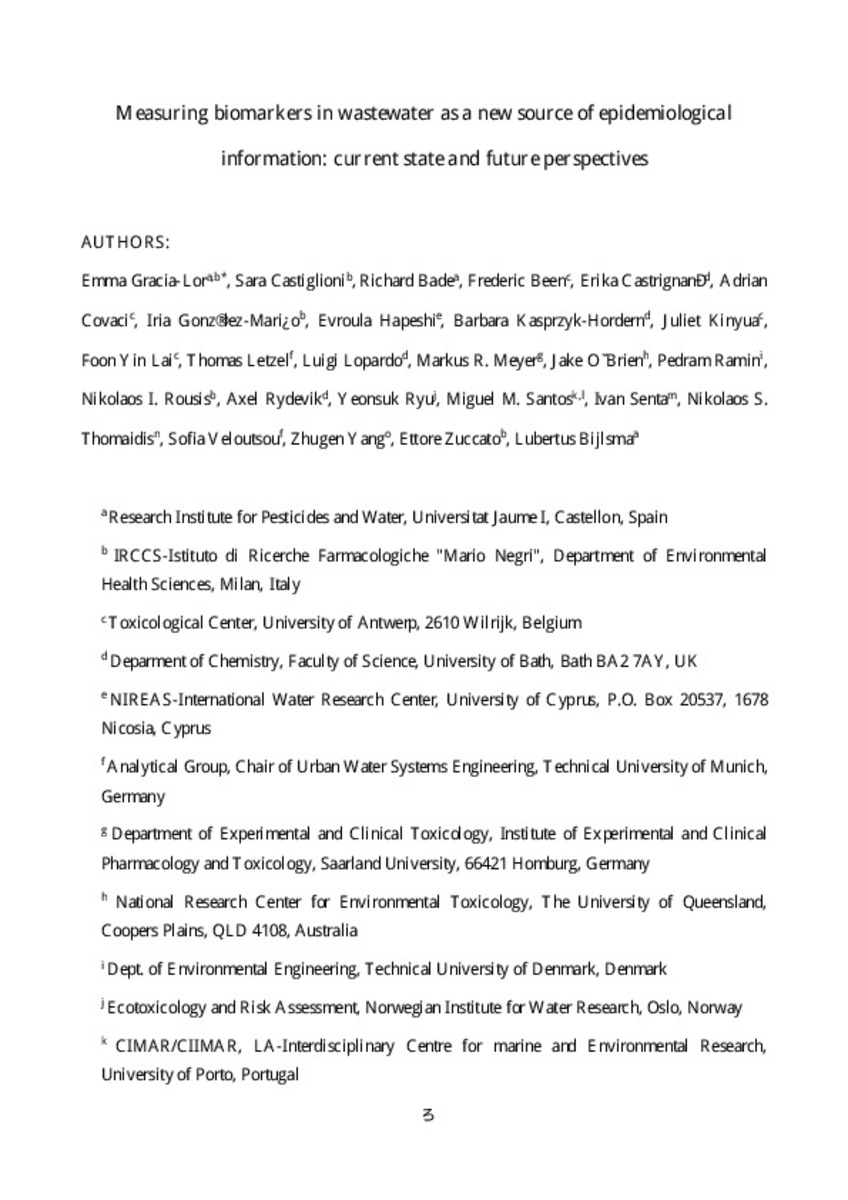Mostrar el registro sencillo del ítem
Measuring biomarkers in wastewater as a new source of epidemiological information: current state and future perspectives
| dc.contributor.author | GRACIA LOR, EMMA | |
| dc.contributor.author | Castiglioni, Sara | |
| dc.contributor.author | Bade, Richard | |
| dc.contributor.author | Been, Frederic | |
| dc.contributor.author | Castrignanò, Erika | |
| dc.contributor.author | Covaci, Adrian | |
| dc.contributor.author | González-Mariño, Iria | |
| dc.contributor.author | Hapeshi, Evroula | |
| dc.contributor.author | Kasprzyk-Hordern, Barbara | |
| dc.contributor.author | Kinyua, Juliet | |
| dc.contributor.author | Lai, Foon Yin | |
| dc.contributor.author | Letzel, Thomas | |
| dc.contributor.author | Lopardo, Luigi | |
| dc.contributor.author | Meyer, Markus R. | |
| dc.contributor.author | O'Brien, Jake | |
| dc.contributor.author | Ramin, Pedram | |
| dc.contributor.author | Rousis, Nikolaos I | |
| dc.contributor.author | Rydevik, Axel | |
| dc.contributor.author | Ryu, Yeonsuk | |
| dc.contributor.author | Santos, Miguel M. | |
| dc.contributor.author | Senta, Ivan | |
| dc.contributor.author | Thomaidis, Nikolaos | |
| dc.contributor.author | Veloutsou, Sofia | |
| dc.contributor.author | Yang, Zhugen | |
| dc.contributor.author | Zuccato, Ettore | |
| dc.contributor.author | Bijlsma, Lubertus | |
| dc.date.accessioned | 2017-01-31T10:27:51Z | |
| dc.date.available | 2017-01-31T10:27:51Z | |
| dc.date.issued | 2017-02 | |
| dc.identifier.citation | GRACIA-LOR, Emma, et al. Measuring biomarkers in wastewater as a new source of epidemiological information: Current state and future perspectives. Environment International, 2016. | ca_CA |
| dc.identifier.uri | http://hdl.handle.net/10234/165745 | |
| dc.description.abstract | The information obtained from the chemical analysis of specific human excretion products (biomarkers) in urban wastewater can be used to estimate the exposure or consumption of the population under investigation to a defined substance. A proper biomarker can provide relevant information about lifestyle habits, health and wellbeing, but its selection is not an easy task as it should fulfil several specific requirements in order to be successfully employed. This paper aims to summarize the current knowledge related to the most relevant biomarkers used so far. In addition, some potential wastewater biomarkers that could be used for future applications were evaluated. For this purpose, representative chemical classes have been chosen and grouped in four main categories: (i) those that provide estimates of lifestyle factors and substance use, (ii) those used to estimate the exposure to toxicants present in the environment and food, (iii) those that have the potential to provide information about public health and illness and (iv) those used to estimate the population size. To facilitate the evaluation of the eligibility of a compound as a biomarker, information, when available, on stability in urine and wastewater and pharmacokinetic data (i.e. metabolism and urinary excretion profile) has been reviewed. Finally, several needs and recommendations for future research are proposed. | ca_CA |
| dc.description.sponsorShip | This work was supported by the COST Action ES1307 “SCORE – Sewage biomarker analysis for community health assessment”. Emma Gracia-Lor is very grateful to Generalitat Valenciana, Conselleria d'Educació, Investigació, Cultura i Esport (APOSTD/2015, Programa VALi + d) for her post-doctoral contract. Lubertus Bijlsma acknowledges NPS-Euronet (HOME/2014/JDRUG/AG/DRUG/7086), co-funded by the European Union, for his post-doctoral fellowship. Erika Castrignanò, Richard Bade, Juliet Kinyua, Pedram Ramin, Nikolaos I. Rousis, Yeonsuk Ryu would like to thank the SEWPROF MC ITN project, ‘A new paradigm in drug use and human health risk assessment: Sewage profiling at the community level’ [grant agreement 317205] supported by the European Union's Seventh Framework Programme for research, technological development and demonstration for the financial support. Iria González-Mariño extends her gratitude to the Galician Council of Culture, Education and Universities for her postdoctoral contract (Plan Galego de Investigación, Innovación e Crecemento 2011–2015). Foon Yin Lai acknowledges her postdoctoral fellowship from the University of Antwerp. Luigi Lopardo, Axel Rydevik and Barbara Kasprzyk-Hordern would like to acknowledge Leverhulme Trust for funding ‘TOX-EDC, Wastewater profiling for community-wide human exposure assessment from environmental endocrine disrupting chemicals in personal care and consumer products’ (Project No: RPG-2013-297). Frederic Been would like to thank the Swiss National Science Foundation (SNF, P2LAP2_164892) for his post-doctoral grant. This publication reflects the views only of the authors, and the European Commission cannot be held responsible for any use which may be made of the information contained therein. | ca_CA |
| dc.format.extent | 19 p. | ca_CA |
| dc.format.mimetype | application/pdf | ca_CA |
| dc.language.iso | eng | ca_CA |
| dc.publisher | Elsevier | ca_CA |
| dc.relation.isPartOf | Environment International Volume 99, February 2017 | ca_CA |
| dc.rights | © 2016 Elsevier Ltd. All rights reserved. | ca_CA |
| dc.rights.uri | http://rightsstatements.org/vocab/InC/1.0/ | * |
| dc.subject | Wastewater | ca_CA |
| dc.subject | Epidemiology | ca_CA |
| dc.subject | Biomarker | ca_CA |
| dc.subject | Consumption | ca_CA |
| dc.subject | Exposure | ca_CA |
| dc.subject | Population | ca_CA |
| dc.title | Measuring biomarkers in wastewater as a new source of epidemiological information: current state and future perspectives | ca_CA |
| dc.type | info:eu-repo/semantics/article | ca_CA |
| dc.identifier.doi | http://dx.doi.org/10.1016/j.envint.2016.12.016 | |
| dc.rights.accessRights | info:eu-repo/semantics/openAccess | ca_CA |
| dc.relation.publisherVersion | http://www.sciencedirect.com/science/article/pii/S0160412016306936 | ca_CA |
| dc.type.version | info:eu-repo/semantics/submittedVersion |
Ficheros en el ítem
Este ítem aparece en la(s) siguiente(s) colección(ones)
-
IUPA_Articles [307]








